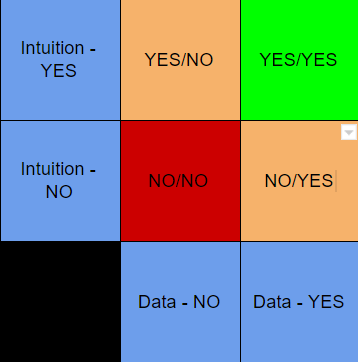There's No Such Thing as a Bad Decision

Decisions are hard.
Making a choice is surprisingly difficult, especially when you have a mutual interest in each possible decision result. These results could be considered “good” and “bad” results. Sure, a very binary response — on or off, yes or no, pass or fail, one and zero. There are times when the results are shades of gray, not necessarily optimal results but not the worst results. You just need to make a decision, you need to make a choice, especially in the gray areas. In reality, the only bad decision is to make no decision. Without getting too ironic, you could argue that making no decision is in itself a decision. I would not disagree with you when it comes to the perfection of language, especially such that a conscious choice to not make a decision is, in itself, a decision. We are defining the ability to make choices, to make decisions, and live with those results.
To qualify this argument, these decisions are not considered life or death decisions, even though we may sometimes be required to make such — most of us are not in that practice or need to expend the effort in weighing human life. Nor are we discussing “simple” decisions such as “do I turn left or do I turn right” or “do I take the stairs or do I take the elevator.” It is more meaty, such as “why buy company umptyfrats, or should I sell everything and get out of the business altogether ?” Or, depending on the value statement, “Do I buy Brand X or do I buy Brand Y” when safety, quality, cost, or delivery are in consideration?
The key is to build the framework and the wisdom to be able to make decisions effectively AND quickly.
Sure, we can create decision trees and develop priority matrices, or create a risk-priority number. Depending on your level of experience, each of those would build your ability to make sound decisions. Sometimes it is necessary to do deep data discoveries, depending upon the complexity of the decision.
However, the best tool is data. Using data to make your decisions places the best value and strongest foundational support behind a decision. When using data, we need to trust the data. There are times when the data says you should make a decision, many people second guess that data value and they become paralyzed.
I NEED MORE DATA…please.
What about intuition? Gut? The justifications are usually “I have been doing this for XX years, I know what I am doing.” We need to realize that intuition, guts, and wisdom are just that, unmeasurable value statements that can add weight to a decision but should not be the sole source of the decision, especially on increased value decisions. Intuition and wisdom come from mistakes and choices that did not go as intended. Although they were a choice, the choice could have been richer if there was some homework.
The key to good decision-making is to use data whenever possible. BUT use intuition AND wisdom in parallel with that data. Yes, I said it — both — combined.
The data meaning actual, critical values specific to the process or product you are wishing to decide upon. There may be times when you need to use a proxy value as a data stand-in if you are unable to measure something directly. Nevertheless, you are going to use data to help with the decision.
Additionally, you will NOT ignore your intuition. Trust your gut. My qualification is that you do not make your decision based only on intuition. Surely, you may have experience from either past successes or failures, allowing you reasonable confidence to make a decision quickly. But without having data, gut decisions are almost a flip of the coin. In this workforce, the highly transitive economy, people are thrust into situations they are unfamiliar with and do not normally participate in that space. That is where data + intuition checks help make decisions.

This matrix makes it easy to make choices. Two NOs — well, there you have it, NO do not do it. The decision is negative. Conversely, two years-tear it up! Go with all your might and do not stop until done! The yellow ones — the ones in between means there has to be a weight of the decision being made. One is heavier on the data decision, the other is heavier on the INTUITION. When you need to make these decisions, take a bit more time, and when necessary, reach for those experts that are of the fields where each decision is weighted heavier. If there is a data king, search her out and have her weigh the data value and decision and allow your intuition to be the flag bearer. But if intuition seems weaker, the data must be more valid, seeking a mentor or a more senior person that may have more wisdom than you may be necessary. Use their experience to help guide you.
Sometimes it may be necessary to look for another indicator that can help you make a decision IF you are afraid to make that decision. Remember, no fear! The goal is to make a decision and move forward, and no decision is going to be a bad decision. Make your decision and move forward on that action and never second-guess that decision, which happens to be the best decision! Trust the process and you will be fine and succeed. With each tough decision, you are going to gain wisdom and experience, and you are going to be able to move forward. The intention is to make sure that you make a decision and not become paralyzed. To not stop progress. Do what you need to do to make sure you keep moving forward.
Or you could just flip a coin.
Go forth and be brilliant.
Comments
Post a Comment